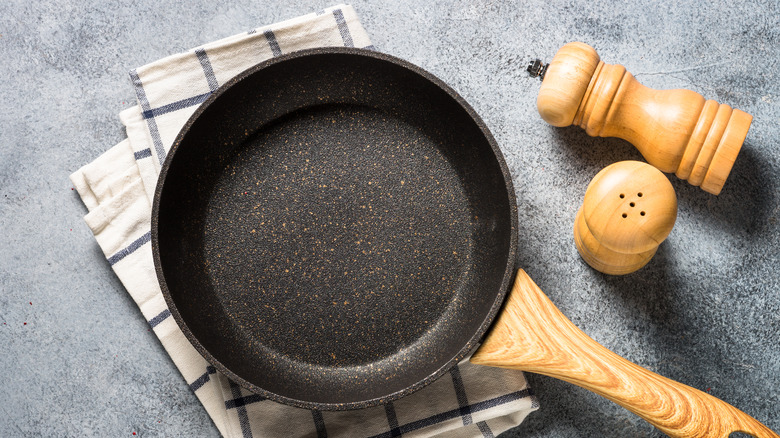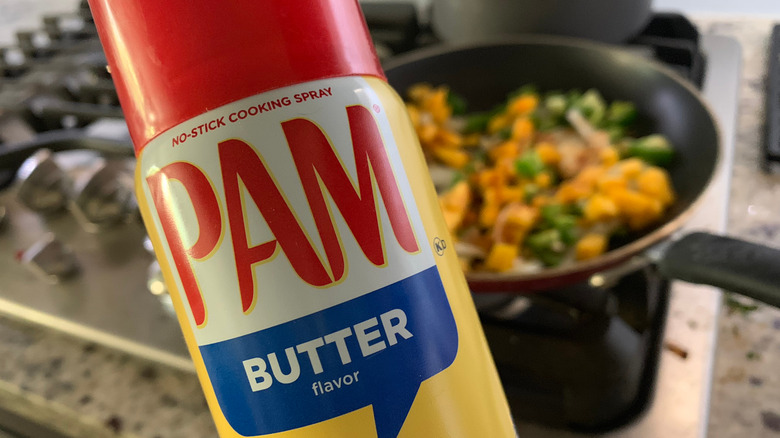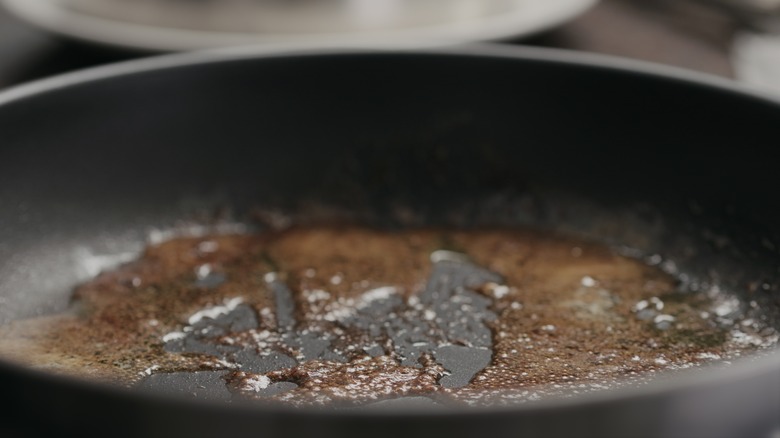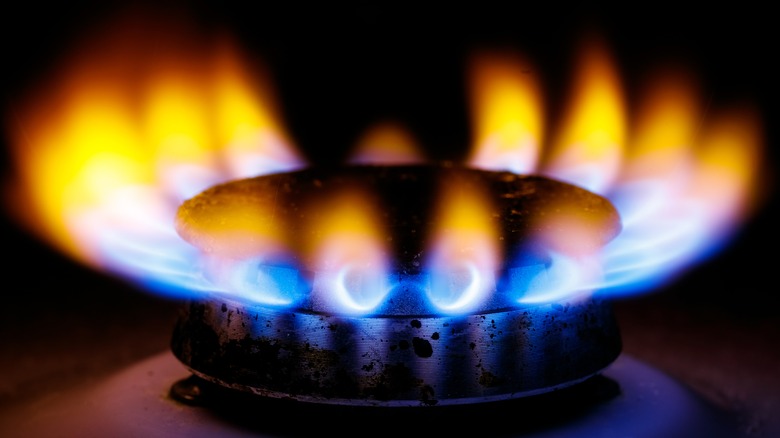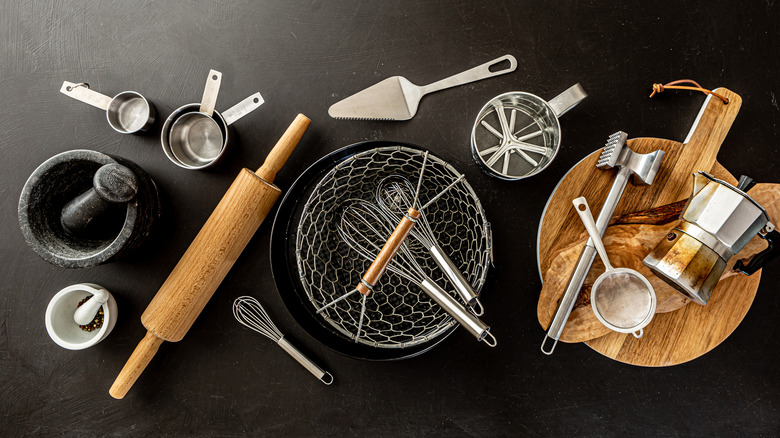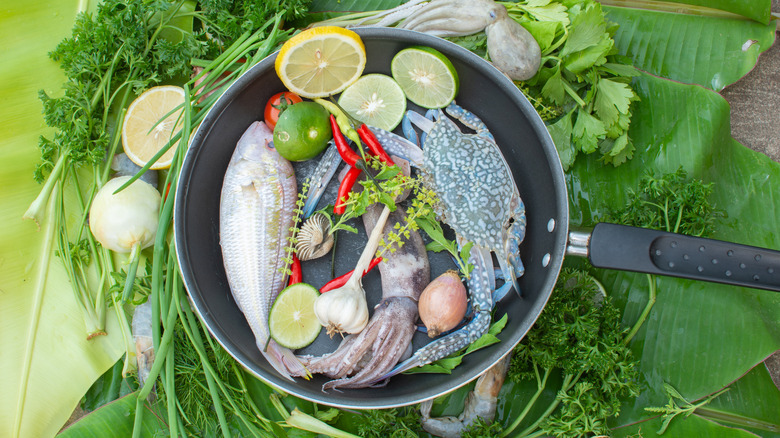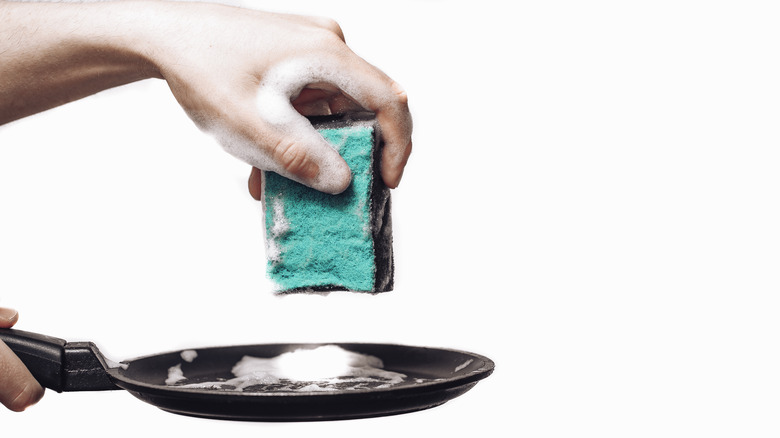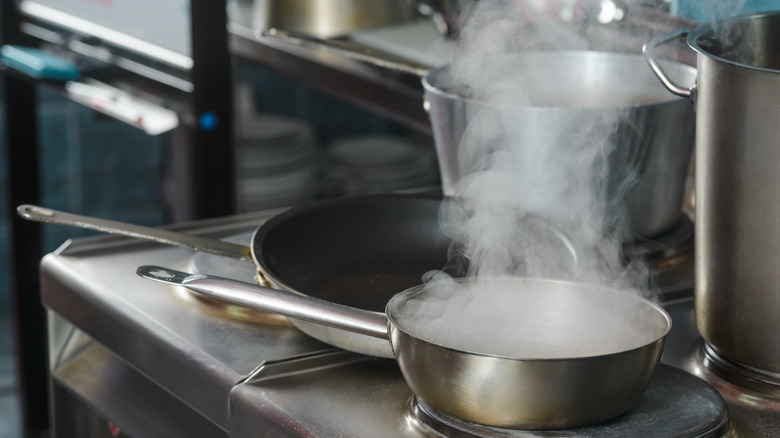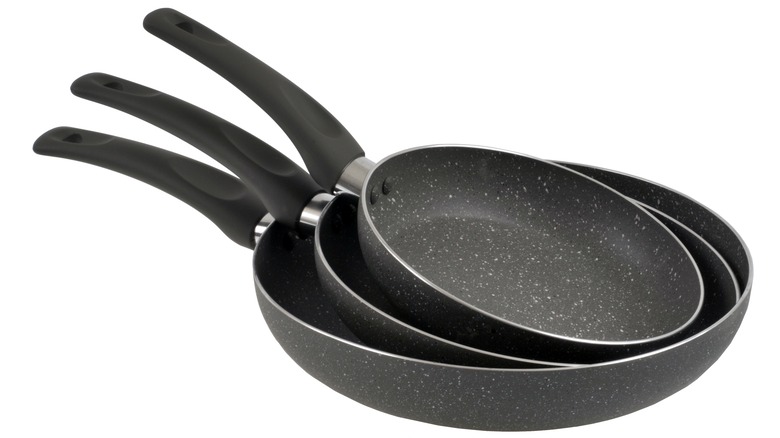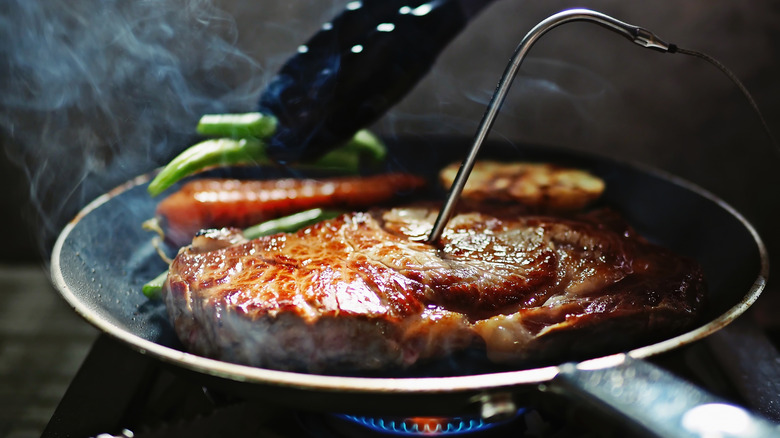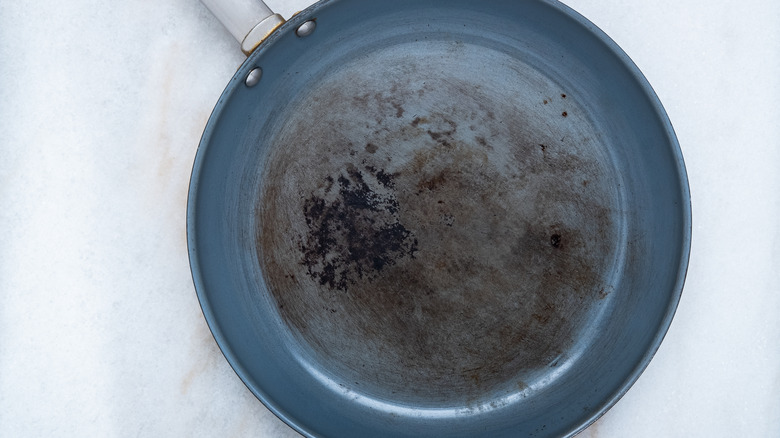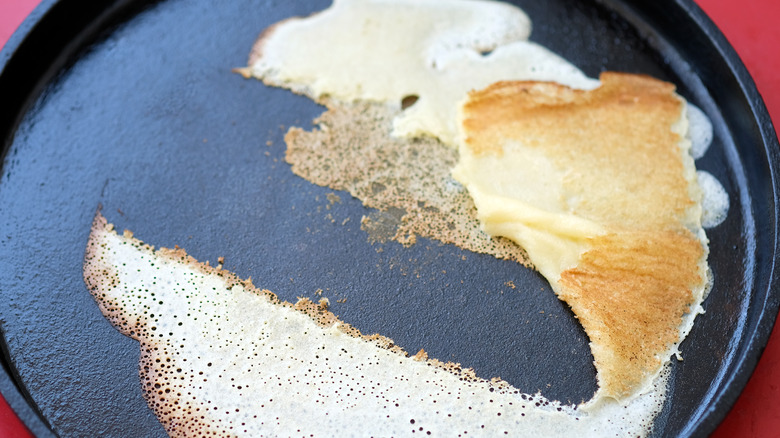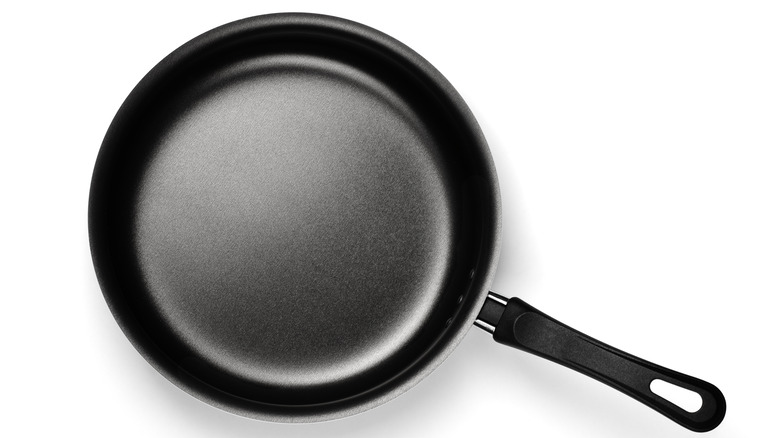13 Common Mistakes Everyone Makes With Their Nonstick Pans
Nonstick pans are one of the most convenient types of cookware you can use. You can prepare food without having to use as much butter or oil as you normally would, and the cleanup process is much easier. The benefits of using a nonstick pan are so great that it's easy to forget how much attention and care these pieces of cookware need to function properly. Lodge Cast Iron explains that the seasoning of a pan is important as it prevents the surface from rusting and, in the case of a nonstick pan, prevents food from sticking to it.
Needless to say, a nonstick pan wouldn't be as useful if it wasn't for its special coating. The layer is helpful but, unfortunately, is exceedingly sensitive to many errors that can be made before, during, and after the cooking process. Nonstick pans can't help you out in the kitchen if you continue to make harmful mistakes. That said, it's important to know what habits are best to avoid with your pans and which to stick with (pun intended).
Using nonstick cooking sprays
Nonstick pans can be used for cooking without the aid of nonstick cooking sprays (it's already nonstick, after all). Besides being kind of useless for this type of pan, nonstick sprays can also be damaging. Anolon, a maker of well-regarded kitchenware, notes that nonstick sprays will cause food to stick to the pan and will ruin the coating. Southern Living explains that a substance called lecithin is the particular factor behind the extreme stickiness between spray and pan seasoning. Nonstick sprays also bond, making them nearly impossible to remove no matter how much soap and water you use. Save the sprays for other types of pans and use butter or oil instead.
Any type of oil should work fine as long as it's used in small doses. For instance, using too much vegetable oil will leave behind excess that can harm the pan's coating like a buildup of nonstick cooking sprays. The most effective way to prepare your nonstick pans for cooking is to lightly spread butter or wipe the oil of your choice around the pan with a paper towel. You can also use a spray bottle to reduce the chances of overusing oil. Butter is especially a productive choice when you want to bake a cake and other goods. As for oil, there's the bonus of adding more flavor to your meal with certain kinds like coconut, peanut, and olive. Without a form of grease, you won't be able to cook with ease.
Preheating without food or fats
Preheating your pan before cooking is crucial in making sure it's ready to be properly used. However, you must never preheat an empty nonstick pan. Teflon notes that an empty pan is more likely to overheat, and the coating can be destroyed without sources of fat like butter or oil. Preheating without food or oil destroys a pan's coating as it doesn't allow the heat to distribute and instead concentrates the temperature, which breaks down the pan's polytetrafluoroethylene compound coating (via The Washington Post). Not only will the coating have less of its desired nonstick effect, but it can also be toxic.
To avoid this, you can grease the pan just as you would when substituting a nonstick cooking spray and let it set for a few seconds. Unlike other pans, a nonstick one can be preheated with the food you're planning to cook already in it (a great method to do if you're short on time). However, you're more likely to have better results if you preheat with a type of fat first just so you can tell if the pan is working as it should. Additionally, you'll want to avoid using too much heat while preheating. Simply start at a low temperature and only increase when absolutely necessary and when food or oil has been added.
Too much heat
Pans wouldn't be helpful for cooking without heat. On another note, you shouldn't use high heat when cooking food in nonstick pans, and for similar reasons as to why you shouldn't preheat your pan without food or oil. The Washington Post reports that it can also be dangerous to crank up the thermometer while cooking. If heated above 500 F (and without something in the pan to distribute heat), nonstick pans will release toxic fumes into your kitchen air. Since the average gas burner can heat up to 3,500 F, and induction burners can reach over 600 F, keeping the heat down is important to remember when cooking with nonstick.
Medium heat is the new high heat when working with a nonstick pan. You'll be able to cook effectively and in a way that keeps you and your pan safe. Low heat works, too, as long as the recipe you're working with doesn't require more. Crispy meals shouldn't be prepared in a nonstick pan because the crunchy texture can't be accomplished without higher heat. You would be better off cooking fried chicken in other kinds of pans like a cast iron skillet. If you'd rather not constantly spend money on new nonstick pans, avoid using high heat at all costs.
Using metal utensils
You can't utilize your nonstick pan without some helpful utensils, but just make sure none are made of metal. Using metal utensils on nonstick pans can be risky for the coated surface. Whether you're using a spatula to flip pancakes or trying to beat eggs with a metal fork or whisk, tools made from hard and abrasive material can scratch the coating and even go deeper to chip the pan. If the surface has become too scratched up, the nonstick layers will no longer work, and you will end up in a sticky food situation. Chipped pieces of the pan can also sneak into your food and rob you of a safe and healthy eating experience if you're not careful.
If you don't have any in your kitchen already, buy some wooden utensils like this Riveira set, which will make for great assistants to your nonstick pans. Plastic appliances can work as well, but these won't be as environmentally friendly as wooden utensils and, if not tested for heat, can also be an unhealthy choice. However, high-heat plastics can still be rougher than metal on nonstick coatings. If wood is not your material of choice, consider FDA food-grade silicone, an antifungal polymer unaffected by temperature and free of toxic substances (via Silicone Engineering Ltd). The softer utensils will withstand high temperatures without leaving chips or divets in your expensive pans.
Cooking acidic foods
Acidic foods are known to be an issue for many types of pans. For example, citrus fruits, tomatoes, or other acidic foods can affect your cast iron pan, breaking the layers that prevent food from sticking to its surface and corroding the metallic molecules. Unsurprisingly, the same issue applies to nonstick pans, and it may actually be more serious with this type of cookware since the seasoning is more sensitive. The high acidity levels of lemons, for example, can deteriorate the pan's coating slowly and surely.
Nonstick pans are technically considered "nonreactive metals," meaning the coating and material does not respond to the chemical effects that introducing acidic food could potentially create (via Martha Stuart). However, to gain this status, nonstick cookware must be covered in compounds like polytetrafluoroethylene, or PTFE. Technically, PTFE is highly stable and won't break down under the threat of acidic or alkaline foods — that is, as long as your pan is in peak condition.
Many nonstick pans are made from aluminum covered in PTFE compounds. Aluminum, per Cook's Illustrated, is reactive to acidic ingredients. So, while a pan used right after purchase is resistant to the corrosive effects of acidic foods, a piece of kitchenware that has been exposed to extensive cooking (potentially dinged or scratched along the way) puts you at risk of consuming heavy metals which will come in contact from the acidic ingredients. You should avoid cooking common acidic ingredients such as alcohol, citrus fruits, and tomatoes with your
Cleaning incorrectly
Nonstick pans need to be cleaned properly to be usable for several years. To clean the pans effectively, you must make sure you're doing so softly. Prohibiting the use of any strong cleaners will prevent any unnecessary damage to a nonstick pan's surface. Better Homes and Gardens notes that using mild soaps and water should be enough to clean nonstick pans without damaging the coating. Always have a plan B just in case. If you find any stubborn leftovers that refuse to leave your nonstick pan (even after washing it), create a small mixture of baking soda and water. Gently scrub all areas of the pan that weren't cleaned enough after plan A and rinse once you're done.
Another important note to keep in mind is what you're using to clean a nonstick pan. Similar to how you shouldn't use metal utensils for cooking, you shouldn't use metal or rough cleaning tools either. Using soft cloths or non-abrasive sponges will help you get the job done effectively without scratching your nonstick pans.
Washing in the dishwasher
There are many reasons why placing nonstick cookware in the dishwasher isn't a good idea. One of the reasons you're probably using a dishwasher in the first place is to save you some time. The more dishes and utensils you can place in your dishwasher, the less you need to worry, right? There's some truth to this idea — unless you throw your nonstick pan into the mix. Other kitchen appliances, especially metal forks and knives, can move around in a dishwasher and can scratch your nonstick pan (thus ruining the coating). Water temperatures within a dishwasher tend to be on the higher side and will cause a problem for nonstick pans, similar to if you're using too much heat on the stove.
A dishwasher's many hazards have led companies to enhance nonstick pans to better handle cleaning via this appliance. Teflon explains that its proprietary type of coating is dishwasher safe as long as you're following the instructions provided by the brand of the pan. Just because a company says a nonstick pan is safe to use in a dishwasher doesn't mean it's guaranteed that there won't be any negative effects. You also need to consider what your nonstick pan is made of since aluminum ones are more likely to be damaged.
Washing hot pans
You've made yourself (and others) a delicious meal, and you want to clean everything in your kitchen as fast as you can, including your nonstick pans. Being responsible with your kitchen utensils is always a great quality to have. Just make sure you never wash a hot pan (especially with cold water). The extreme temperature differences between your nonstick pan and the water will cause it to become misshapen, as the metal will begin to pull against itself at differing temperatures. This reaction causes the formation of the pan to warp, leading to an uneven bottom or crooked sides. Rapid temperature changes not only will ruin the bottom of your nonstick pan, but a reaction called thermal shock can take place. Thermal shock can cause pans to develop hot and cold spots, leading your pans to cook unevenly.
Let your nonstick pan cool down to the point it has reached the minimum room temperature before you start cleaning. Pour a mixture of warm water and mild soap into the pan and let it set for a little while. Doing so will help maintain a consistent temperature and remove residue like burnt oil.
Stacking pans
There's a right and wrong way to store your nonstick pans. Stacking pans directly on top of each other is the wrong way. The reason why you shouldn't be stacking is probably an obvious one. Friction between the pans is an easy way to cause damaged coatings, scratches, and even pieces of the pan to be chipped. If you have a small kitchen and don't have a lot of space to store your nonstick pans (which is why you've probably resorted to stacking before), don't worry. There are other effective methods you can use.
Hanging nonstick and other kinds of pans is the most recommended alternative. You can approach this method in many ways, like buying or making a rack to put on your wall. You can also place hooks that can handle a decent amount of weight under or over a shelf depending on what is safer in your kitchen. If you seriously have nowhere to hang up your nonstick pans, the only way stacking is passable is if you put soft cloths in between to protect the surfaces.
Trying to sear or caramelize food
Going back to the importance of not overheating your nonstick pans, Good Housekeeping notes that nonstick pans shouldn't reach any higher than 500 F. If you're planning to sear or caramelize your food, it's best to choose another type of cookware. While the scientific origins of the Maillard reaction weren't initially geared toward grilling, these days, it is considered an important piece of food science for home cooks interested in getting crisp, finished edges on their food. The Maillard reaction works when high heat is applied to amino acids, transforming the characteristics of proteins and sugars. To have this searing technique done effectively, Weber Grills states temperatures need to be between 300 F to 500 F — a range that we know is dangerous for nonstick pans.
That said, for the foods you prefer to have a good sear on, it's best to use a pan that can take the heat. Steak and burgers are some examples of food that is normally seared but are better off in another type of pan. Per cattle ranchers Lone Mountain Wagyu, the Maillard reaction works between 355 F to 450 F for beef.
Temperatures like those will be stressful for your pans, and if you lower the heat to accommodate it, you'll then put your meat at risk of being undercooked. Instead, prioritize foods that don't require as much heat, like bacon, pancakes, and scrambled eggs (sounds like a perfect breakfast if you ask us).
Using a pan with severe damages
If you have a nonstick pan with broken handles, discoloration, or severe damage to the surface, refrain from using it. You don't want to accidentally eat chipped pieces of your pan or ruin future dishes. Scratched nonstick pans can be safe to use, depending on a few factors.
If you own a Teflon nonstick pan that was made after 2013, you're in luck. These nonsticks are safer to use and last longer due to a change in production material that occurred around this time. Nonstick pans made before 2013 contained a coating known as perfluorooctanoic acid (PFOA), which SFGate explains has been linked to cancer in lab animals and which the CDC notes can remain in the body for extended periods of time. Scratched nonstick pans made earlier than this date are not safe to use, and should be discarded.
However, if your pan is younger than 2013, you can repair it from small scratches through re-seasoning. You'll need to make sure your nonstick pan is clean first. Mist even layers of a nonstick cooking spray over the pan's surface, then "cook" your pan in the oven at 500 F for no longer than 45 minutes. (This is the only time your pan should reach this temperature!) If your nonstick pan isn't oven safe, you can boil a mixture of baking soda, water, and white vinegar in the pan for about 10 minutes. Rinse and re-season the pan with vegetable oil.
Keeping your nonstick pan for too long
We should start by saying that we would never advocate for creating undue waste. Grocery stores are often struggling with food waste, and the last thing the Earth needs is more trash being thrown into a landfill. Still, one of the biggest mistakes you could be making with nonstick pans is that you're keeping them too long. As we've mentioned, pans that are over 10 years old are already putting your health and food quality at greater risk due to the unsafe materials that these pieces of cookware were previously made from. But, pans that are within a manufacturer's date aren't free from getting the boot either.
There could be a good reason your nonstick pans stick to food, and each of these is a sign that it is time to refresh your cookware collection. Reader's Digest tells it straight: nonstick pans aren't immortal. To determine if the integrity of your pan and its coating have been compromised, you'll want to look out for a few things; If your cookware is significantly changed in color, has a funky shape, or doesn't heat food evenly, it has met its end. As we've mentioned, there may be a few ways to cure a scratched pan, but not every method is foolproof, safe, or even effective. Scratches that are too deep set might not be repairable and may cost you in more ways than just monetarily.
Money doesn't equal quality
In most cases, the best cookware you can get is on the pricier side of the aisle. You can forget that idea completely when it comes to nonstick pans. If you have the means to choose between a cheap versus expensive nonstick pan, you might think that spending more money will make your cookware immune to some common issues. Pans of any price are susceptible to the same mistakes if used incorrectly.
Swiss Diamond HD Pro is considered to be one of the best nonstick skillets because of its sturdy handle, strong surface, and stainless steel-aluminum composition. It's also labeled as dishwasher and oven safe. The catch? The 9.5-inch skillet costs about $170, and the larger 11-inch costs about $200, while reviewers not that it becomes discolored and stained over time.
Target may not be the hip place to purchase nonstick pans, but the store retails Faberware, a brand with a reliable three-piece nonstick cookware set that offers the majority of desired traits that higher end skillets have. The pans are made of aluminum, have a similar Diamond coating, solid and ergonomic handles, and are dishwasher safe (remember to take the occupational hazards of putting your nonstick pans in your dishwasher into account). The best part? The set costs about $25 (that's 1/8th of what you could spend on the other skillet).
